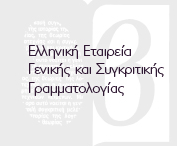Δε διατίθεται περίληψη.
(EL)
This paper looks at some of the presumptions and contradictions off in de siecle literary aestheticism in relation to aspects of modernity of which it is paradigmatic. Taking Baudelaire's poetry and essays as a starting point, Ι pinpoint the sense of ephemerality and the concomitant "cult of the new" as expressive of the nature and logic of modernity. These features can also be found at the heart of aestheticism's conceptualization of art and the Subject, interwoven with a problematic of emotions, and especially of pain and pleasure. The aesthetes went against both dominant puritan morality and realist aesthetics by rejecting art's claim to truth value or reflecting the real, and by focusing, inversely, on form. However, despite the common perception that aestheticism's theory of art is purely formalist, Ι argue that, on the contrary, at the theoretical core of aestheticism lies a concern with emotions. According to Walter Pater's influential study The Renaissance and the critical and literary writings of Oscar Wilde, on whom this paper focuses, the life ideal that is achieved more fully through art is the experience of rich emotions and of new, intense sensations which offset the inevitability of mortality and the ephemerality distinctive of secular modernity. Wilde paradoxically defines art as superior to life on the grounds not only of the inexhaustible and strong sensations it can offer but also, and more importantly, for the mutual avoidance of pain and achievement of pleasure it can serve. Art provides pleasure at our request and it literally functions as a virtual "anaesthetic" to the pain caused by actuallife with its imperfections and disappointments. This theory is emblematically illustrated in the famous novel The Portrait of Dorian Gray where, following its archetype, the scandalous Α Rebours byJoris Κarl Huysmans, there is dramatized a displacement of human relations and emotions in the world of art, and more precisely ου the surface of an artwork, the portrait of the hero who, inversely, is increasingly presented as a "face without a heart"; a predicate that would suit a portrait better than a human being. Wilde's definition of art's function as a "shield to pain" is comparable to Sigmund Freud's observation in his later "Beyond the Pleasure Principle" that consciousness in essence works similarly as a mediator, a shield to external stimuli which may prove painful or dangerous for the Subject. In the novel, the portrait has assumed the role of the hero's consciousness, functioning as a shield to aging and the degrading effects of his (evil) real actions. The inexhaustible range of pleasurable experiences and sensations that Dorian enjoys as well as his proverbial cruelty to others, to his actress-lover, the painter Basil, the young scientist and a number of young women and men, stem from his immunity to pain that is ensured by his portrait, by art. At the same time, however, from a historical point of view, the subjectivity represented by dandy Dorian rests on the model of new Hedonism" propounded in the novel as the "ideal of the new age" by Lord Henry, the spokesman of aestheticism in the novel. Going for ever-new pleasures, eternal beauty and youth, Dorian epitomizes the performative, mutable and pleasure-seeking "type" of self which is the outcome of the blending of narcissism with consumerism peculiar to modernity. In this sense, despite the putative formalist elitism of the aesthetes and their supposed objection to the realist dogma of art's dependence on life, the vulgar, anti-intellectual sentimentality and the rising mass culture of their times, they are also proved to comply with the consumerist rhetoric of the market and bear witness to secular modernity's inability to handle death anxiety and pain by repressing them, while it simultaneously keeps causing them by its relentless promotion of the ever-new and pleasurable.
(EN)

